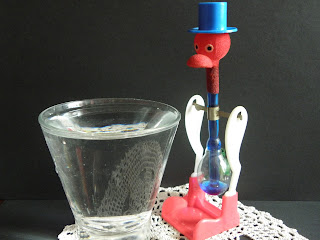Returning to toys, and following a recent conversation, here's something else. The Drinking Bird, sometimes called a Dippy Bird or Dipping Bird, looks like a simple toy but is, in fact, quite a clever demonstration of the laws of thermodynamics. In this house, we obey the laws of thermodynamics.
The bird is a heat engine. It is a made from two glass bulbs, with a tube extending from the bottom of the top bulb down into the body of the bottom bulb. The bulbs are vacuum sealed and contain a liquid - usually coloured either blue or red, (mine is blue). The liquid is methylene chloride ( CH2Cl2 - also called dichloromethane), which is a solvent, used as a paint stripper and degreaser, and is used industrially in the decaffination of coffee. It is an irritant to the skin (and lungs, if inhaled), and is potentially carcinogenic - so if a Drinking Bird breaks, ventilate the area well and immediately. In normal use though, the bird is safe, but it is not a children's toy, so should always be used under supervision.
Methylene chloride has a very low boiling point - just below 40 degrees centigrade - and, in accordance with Maxwell-Boltzmann distribution, is capable of existing in more than one state at the same time, so although the bulbs seem half-empty, they have methylene chloride in both its liquid and gaseous states. This is important, as it governs how the heat engine works at room temperature.
The bird, typically, has a fuzzy-covered head, wears a top hat, sports a feather as a tail, and pivots freely on a stand. The bird stands in front of a water-source, usually a drinking glass, and to activate it, its beak is dipped into the water. The bird will rock backwards and forwards slowly, almost coming to a vertical standstill, then will suddenly dip forwards, dip its beak in the water, return to the vertical, and repeat the process over again.
So how does it work? The secret is in the physics, and is a demonstration of several important principles. The whole thing starts with that initial dipping of the beak in the water. Through capillary action, the water spreads across the fuzzy head of the bird, whence it begins to evaporate. As it does so, the temperature inside the top bulb drops slightly, which causes the methylene chloride gas to condensate and return to a liquid state. This in turn causes the pressure in the top bulb to drop, which draws liquid up the tube from the bottom bulb, as both bulbs seek to equalise the internal pressure differential of the vessel. As the liquid leaves the bottom bulb, the pressure of remaining vapour increases, pushing more fluid up the tube. As the top bulb fills, the bird becomes top-heavy until, eventually, it tips forward, dipping its beak into the water. As it does, the bottom of the tube is no longer submerged and bubbles from the base run up to the head, displacing the fluid, which in turn runs down the tube and into the base, this weight causing the bird to return to the vertical. The whole thing repeats, and repeats, but it is not, as some think, a perpetual motion machine (as it depends on an external heat source - in this case, room temperature).
 |
| Sullivan's Original Diagram from his patent application. |
The Drinking Bird was invented by Miles V Sullivan in 1945, and co-developed by G H Shackley, being patented in 1946. They are readily available to buy today and still have the quaint period charm of the original.

No comments:
Post a Comment